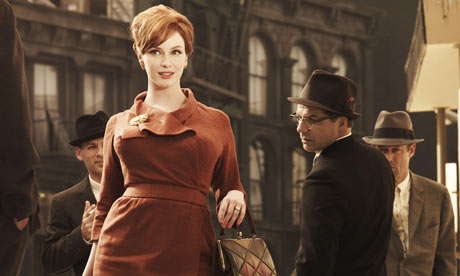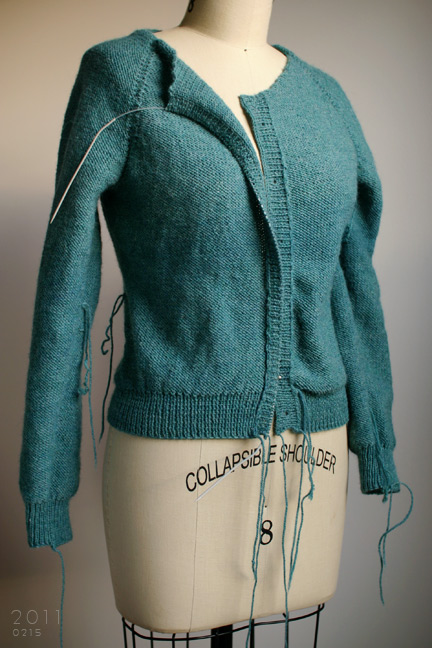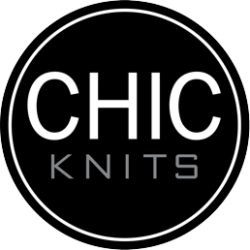Somehow, every time I knit on my current cardi project, I have a Joan Harris moment.
All of a sudden, I, with my red french-twisted hair am wearing a tight pencil skirted dress and this sweater is draped around my shoulders as I sashay through my day…

Maybe not.
But it’s getting closer and closer to the finish line (and the days are getting longer and longer so who knows :p )

I’m at the buttonband stage of this frisky little turquoise cardigan and just for kicks and grins, I thought I’d portrait it inside out.
There’s a certain charm to seeing the architecture of the sweater this way – lots of little strings hanging everywhere, but a real sense of order too. Revealed is the functionality of the parts; the hopefulness of that cuff; the pleasure of that front band with its straight-edged picked up stitches.
I used a technique on this sweater that I really like. Now, for the most part, patterns call for ribbing to be stitched with needles in sizes that are much smaller than the body of the sweater.
The origin of this tradition is not from a fashion POV, but from a warmth factor. Tight ribbing = sealed edges: wrists, neck, hem. Out damn cold, OUT! But the 1×1 ribbing looks very sweet to my eyes…

Here we see it made with a needle two sizes down from the body size needle.
Because of the nature of the yarn (wool/aplaca) the end result is still pliable and can be smoothly blocked out to not strangle in the wearing.
But it’s just too big for what I want to do next: the buttonband.

So, in the making of it, I went down one more needle size so I could craft a denser non-floppy band. Button banding is one of the finest arts of sweater making – and maybe one of the least understood, most despised.
There are no 100% clear cut rules about the pickup ratios; all the ones in my repetoire are starting points. All the instructions given in a pattern are that as well, since the end result will be a function of YOUR row gauge and the characteristic of the yarn itself. In the top ten of help emails I receive are questions about why someone’s buttonband is different than that described by the pattern.
I try and do the math to incorporate the physical temperment and gauge of the yarn I used, but alas, milage will vary, even in my own work! It’s just the nature of the beast.
The silver lining in the cloud is that once you’ve done one or two, those parameters become second nature – and it’s easy to “read” the nature of your materials and the architecture of the sweater and understand if you’re going to deviate much from the baseline instructions. The idea of “reading” one’s knitting is something that is very exciting and possibly accompanies any EUREKA moment you’ve ever had. Your brain, sight and touch click together in a trinity of understanding that is quite wonderful.

And once you’ve learned a technique like buttonbands or discovered a characteristic of lace decreasing or learned how to shape an edge, you will be able to read those moments in advance on every project that comes next.
So my question to you, dear readers, is: if a pattern called for three needle sizes instead of the traditional two, would you oblige? Do most knitters have a range of needles to take advantage of this technique?


I’m not that experienced of a knitter, but I think that three needle sizes in a pattern should be fine. Everyone I know has an interchangeable set plus extras, and I imagine that anyone who has knit at least one sweater already is going to have a variety of needles from checking gauge, knitting prior projects, knitting with various weights of yarn…
That said, I personally am going to avoid the button band for as long as I can hold out.
I will usually try what the designer says before I shoot off on my own. If it didn’t look good I would take it out and start over again. That said, having a little blurb about why you did it in the pattern itself wouldn’t hurt either.
Two, three or four needle sizes – whatever it takes for a professional look is fine. I kind of doubt that there is a size I don’t already have.
I’d definitely oblige. As you say, you want a much denser fabric for the button band to provide stiffness, and as around the buttonholes is one of the most under-pressure regions of a sweater, it seems sensible to add strength to the region by increasing stitch density. I think you will need to describe the pick up rate very carefully though, as puckering is very possible.
I would wonder why, given your argument I would probably use the third size, but then again I have a habit of not reading patterns too thoroughly, so maybe I wouldn’t.
I would oblige — typically, I have to purl with a smaller needle than I knit with anyway. I make sure I have at least 3 (if not 4) needle sizes handy to get the results I want. Bring it on!
(PS – I love seeing the sweater inside out and in progress!)
I would follow the directions and I think most knitters have a wide range of needles, so this shouldn’t be a problem. Lovely, lovely sweater!!
I don’t think there would be a problem with specifying more than two needle sizes. Plus, for me at least, needle size is a suggestion as I rarely get gauge to match that of the designer with the suggested needles….as in how do you possibly get 5 stitches to the inch on sz 10 needles with worsted weight? We learn to modify as we go along and understand our style. Hey, BTW your designs are all over the newest yarn Barn of Kansas catalog. You rock, congrats!
I would use three needles if called for in a pattern, as I feel the designer of a pattern knows what’s needed for the best result. As I love cardigans over any other type sweater/vest I would try it anyway just to see if the buttonband on this and all future cardigans would be better when worked with a smaller needle. Thanks.
No problem, in my opinion, on the number of needle sizes required/requested/suggested in a pattern. I think that anyone making the committment to knit a sweater either owns the needles or is willing to make an investment in knitting at that point and buy them.
I think to specify, especially when you relate it to the fiber that you are suggesting, makes a lot of sense. For example, I just finished a sweater in the same yarn (or the light version, not sure which you are using), and I went up a needle size from the body to do a attached I-cord edging because that’s what worked well and matched the ribbing.
Folks who go for a whole sweater will pay for the extra needles or tips, or borrow them.
Other than adapting needle size for gauge, I would follow the designer’s instructions. If I didn’t have the necessary needles, I would be pleased with the opportunity to purchase more needles!
I have no issue with a number of different needle sizes. What would be nice, as an addition, is the gauge achieved with each needle size. Often, a pattern will have a gauge for the needle size used for the bulk of the garment, but not for the lesser used needle size. It could be, a knitter needs to go down three sizes of needle or up rather than the traditional one or two sizes, but without the additional information, the knitter does not know that.
That being said, more than about 4 for a cardigan could be a bit annoying. I understand the ribbing, buttonbands and main body all being knit on separate size needles for a best fit. Of course, I live in a mild climate, as compared to Chicago, so I don’t necessarily want my cuffs as snug. A knitter in California or Florida may not want snug cuffs at all, or may appreciate a little breeze through the button band.
These are all great! Thank you so much! :)
Keep ’em coming –
I routinely use a variety of needle sizes to make sure that I get the effect that I want (ie. for casting on, binding off, not saggy buttonbands, collars etc.). If it takes 3 or more needle sizes to complete a project, so be it.
I would oblige. Your sweater is classic and very pretty!
I am on a 1×1 ribbing kick right now. I’m doing a bottom-up retroish raglan cardigan that has 4 inches of 1×1 rib at the waist. After finding an older post of yours about steaming 1×1 buttonbands to fix the bunching-up thing that happens at the bottom edge, I’m inspired to make an exception to my garter-stitch buttonband rule :) Thanks for that!
BTW, one thing I almost never do is work the buttonbands at the same time as my sweater. I like being able to decide at the end what to do–and to redo if necessary.
I think with the interchangeable needles that are so popular and reasonably priced – yes, knitters do have three sizes available. When knitting in the round, I’ve found I have to have a lot of cable lengths and sizes available so what’s one more? Pretty sweater BTW.
It’s a great reason to go to the yarn store to buy more knitting needles (and yarn)! :-)))
Multiple sizes are fine.
I have so many multiples of every size, it’s not a problem.
Fit and function are more important.
I have lots and lots of needles so it would not be a problem for me. Also, I would not have a problem purchasing another knitting needle if I needed.
Ditto with all the above comments…..whatever is needed for an extremely presentable garment, and who needs an excuse for buying more needles?? i.e. unless as myself, you are a lover of anything which will help make one a better knitter and produce better quality garments and has umpteen sets of needles in all sizes, lengths and types….tho there is always more to learn in the world of knittting!!
Absolutely, three needles would not be too many to produce a product I would be proud of and happy with in the end. Then I’m ready for another project. Needless to say, I have a veritable “store” of needles right at home. Write your patterns and tell us what you think is best. I will follow.
I would definitely use the required needles. As I am a tight knitter, I am typically not working on the stated needles anyway. Perhaps, an effect/reason/need could be listed that way I can adjust accordingly. I am a relatively new knitter, but have jumped in with both feet as they say. I originally bought a set of interchangeable circulars that I use for everything. Now, I have a second set.
I do not have a problem with multipe needle sizes. That said, I probably would not go down 3 needle sizes. I tend to knit rather tightly and usually do not need to go down that much to get the desired result. I would start with 2 sizes down and decide from there.
I agree , it would be no problem using 3 needles but it would also be great to have gauge on all 3 needles
Definitely no problem – great idea btw, to get the ribbing snuggy. I am long-waisted so I almost always add an inch or more to the body, and/or the armhole depth, so patterns that give x amount of stitches to be picked up for front ribbings are never what I need to do – ratio would be much better. As you say, these things come with experience and confidence but you as designer have the difficult task of covering all these bases.